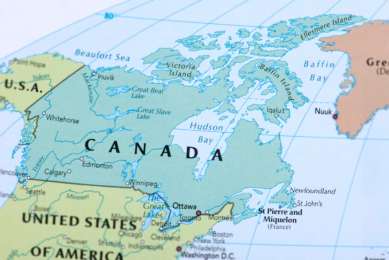IPVS Congress in Canada means a major step forward

The Olympic Winter Games have just been closed down as Vancouver, BC, Canada is getting ready for the next big event: the 21st edition of the IPVS Congress. Despite adverse times for the pig industry, the North American country is looking forward to receiving the more than 2,000 pig veterinarians, says Dr Ernest Sanford, IPVS president.
“I think an IPVS Congress is always uplifting. It gives you many ideas, new developments and new insights. In addition, you meet old colleagues, people you haven’t met for some time. Canada made several tries to organise the IPVS Congress but until 2006 the previous bids proved unsuccessful. The first bid was for Toronto, in 1990. A second bid went for Calgary in 2004 – that failed also. We have been discussing these results both inside and outside Canada. Our conclusion was: maybe we should go for Vancouver. The city had been suggested from the beginning by a couple of members from our local committee. Vancouver is a really picturesque and beautiful city. It has a very international flavour. It is a top tourist destination and a top liveable city; it’s one of Canada’s most attractive locations. In addition, it is very easily accessible by air, from all corners of the earth, not just for Americans, but also from Europe, Asia, Australasia. You don’t want to change too many flights to get to the destination. So we went for it. In 2006, in Copenhagen, we were happy to have an overwhelming vote. During the voting procedure, there’s a system in which after every vote, if a clear majority is not gained, the bottom bid is dropped. That did not even happen as we had the majority on the very first ballot. For Canada, organising the IPVS has meant a huge step, if only because it made us set up a Canadian Association of Swine Veterinarians, which is a major step forward. ”
©
The Congress
“There shall be a lot of Canadian flavour to highlight the social events. Some flavourings refer back to themes that reflect our First Nations peoples. For instance, the design of the pig in the IPVS logo is inspired by the Haida, the dominant First Nations people on our Pacific Coast. The Haida are probably best known for creation of their totem poles. The Congress shall also be incorporating some of Canada’s French history. French-speaking communities are present throughout the country, not only in Québec. Speeches will generally be done in English but there would be some French as well in between. There are over 1,200 abstract submissions – that is a huge record for abstract submissions, as IPVS Congresses never had 1000 abstracts submitted previously. We expect Circovirus and PRRS to top the lists, like in previous years. In addition, pandemic H1N1 will jump into significance. We can also expect an emphasis on food safety and antimicrobial resistance. The last certainly has won attention since it’s now before the US Congress. In addition, CBS TV recently did a scathing, one-sided broadcast on it that has been refuted by Iowa State professor Dr Scott Hurd and others. Last but not least, this year we’ll have a keynote presentation on animal welfare. We will have a lot of veterinarians whose business is on a day-to-day basis to be combating diseases. Issues relating to animal welfare are not necessarily at the top of their daily list, but with society’s activist groups making more and more demands on welfare issues attention has to be paid to this theme. It’s our task at the IPVS Congress to bring veterinarians up to date on animal welfare.”
©
The organisers
“The exact number of people on the organising IPVS committee is twelve. There are three executives, John Harding, Al Theede and me. Then we have two co-chairs for the scientific work, Bob Friendship and Sylvie D’Allaire. There are two co-chairs for sponsorship; Camille Moore and Neil Shantz; and there are two co-chairs on the social committee, Julie Ménard and Madonna Benjamin. On the technical tours, two chairs are working, Chris Byra and Rick Stanley and latterly Gail Cunningham joined us specifically to organise the Hog Jog. In the months leading up to the Congress, IPVS work has kept me busy. A lot of it is e-mail work – I have tried to cover emails from the early morning and I try to reply whenever traffic comes in.
©
As for our team, we have a monthly conference call, in which most of the local organising committee attends. We seldom get together face-to-face for the IPVS. We met at AASV meetings where we usually are all present; or at the Leman Conference, or sometimes at the Western Canadian Association of Swine Veterinarians annual meeting. But for the most part, we did not meet face-to-face.”
©
The industry
“The pig industry in Canada is not in very good shape. In 2006, Canada had top pig production and we were one of the top two or three pork exporting countries in the world. Nowadays things have changed, pork production is in decline. At the time, we had 1.6 million sows, producing 32 million pigs per year. Now we have less than 1.3 million sows and production will be 25-26 million. And it is going to be less in the months ahead. Reason number one for that is the rapid increase of the value of the Canadian dollar. At the time we had $0.63 to the American dollar, but recently we have even been as high as $1.10 above the American dollar. Reason number two is the substantial switch towards using corn to produce ethanol which has increased the price of corn for all pigs. The third factor having a big impact is the US Country of Origin Labelling (COOL) legislation. After COOL was introduced, our export of market hogs went down 80-85% and early weaned pigs dropped 35-40%. The final nail in the coffin was the human pandemic H1N1 influenza outbreak last year, which was erroneously called swine flu. The IPVS Congress cannot change that picture for Canada. There are too many macro factors in the world, like the price of oil and the role of the US government. In Canada we are trying to attain a new level of production and then build back up gradually. I am confident that there will be a new stable herd. But the rapid growth of the late 1990s and the early years of the new millennium will not happen in the foreseeable future.”











